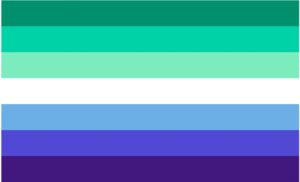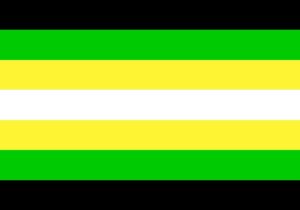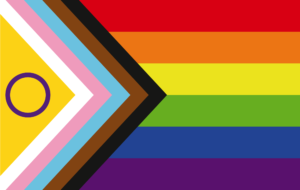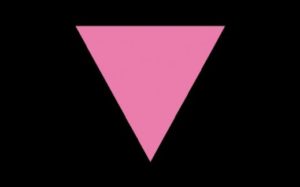Pride Flags
Pride Flags Information
Many people use the rainbow flag to represent the LGBTQ+ Community, but it’s not the only flag that people in the community connect with. Different groups, genders, and identities have come up with their own flags over the years to bring awareness to their unique needs and experiences.
Pink Triangle Flag
This brightly colored symbol is now often worn proudly, but it was born from a dark period in LGBTQ history and world history.
Just as the Nazis forced Jewish people to wear a yellow Star of David, they forced people they labeled as gay to wear inverted pink triangles (or ‘die Rosa-Winkel’). Those thus branded were treated as “the lowest of the low in the camp hierarchy,” as one scholar put it. It’s thought that somewhere between 5,000 and 15,000 men were sent to concentration camps for reasons related to sexuality, but exactly how many died in them may never be known. Flying the pink triangle is a reminder of the past and a pledge that history will not repeat itself. This symbol was widely replaced by the creation of the rainbow pride flag.
Gilbert Baker Pride Flag
In 1978, Harvey Milk, the first openly gay elected official in California, asked artist Gilbert Baker to create a Pride flag. Gilbert wanted to create “something that was positive, that celebrated our love.”
“A Rainbow Flag was a conscious choice, natural and necessary,” Gilbert said. “The rainbow came from earliest recorded history as a symbol of hope.”
The colors have the following meanings:
Pink: Sex
Red: Life
Orange: Healing
Yellow: Sunlight
Green: Nature
Turquoise: Magic
Blue: Harmony
Violet: Spirit
1978-1999 Pride Flag
Following Harvey’s assassination in 1978, demand for the flag increased. Gilbert, however, found the pink color hard to come by, so he opted to decrease the number of colors on the flag to seven in order to keep up with the demand.
Rainbow Gay Pride Flag
This flag is used to symbolize the overall LGBTQ community. Many organizations and businesses use this flag as a symbol to show that their establishment is a safe space for everyone in the community. The pink and turquoise from Gilbert’s original flag were excluded so it would be easier to mass produce.
Philadelphia’s People of Color Inclusive Flag
This flag was created in 2017 to give representation to black and brown people in the LGBTQ+ community and the unique challenges they face. A source told Philadelphia Magazine, “With all of the black and brown activism that’s worked to address racism in the Gayborhood over the past year, I think the new flag is a great step for the city to show the world that they’re working toward fully supporting all members of our community.”
Actress and director Lena Waithe turned heads when she wore a cape featuring these colors to the 2018 Met Gala.
Queer People of Color Flag
The origins of this flag are unknown, but it represents solidarity with the BLM movement and the intersection of the queer and Black communities. It gained notoriety in 2020 during the height of the BLM movement.
“Progress” Pride Flag
This flag was created in 2018 by Daniel Quasar in response to Philly’s updated pride flag. It combines the colors and stripes from Philly’s version of the pride flag and the colors of the transgender pride flag.
On the flag’s Kickstarter, Quasar says, “When the Pride flag was recreated in the last year to include both black/brown stripes as well as the trans stripes included this year, I wanted to see if there could be more emphasis in the design of the flag to give it more meaning.”
Bisexual Flag
Bisexuality can be defined a few different ways depending on who you ask in the community. For many, it’s seen as attraction to both men and women. Others use it to describe attraction to more than one gender, but not all genders. Some even describe it as attraction to the gender you identify as and at least one other gender.
According to Pride, this flag was created by activist Michael Page. He wanted to create a symbol for bisexual people to feel connected to. Each of the colors symbolize some kind of attraction:
Pink (or magenta): Same-sex attraction
(Royal) blue: Opposite-sex attraction
Purple (lavender): Attraction to both sexes.
Pansexual Flag
Pink News says it’s unclear who actually created this flag, but ever since it started showing up online in 2010, it’s become a symbol of attraction to all genders.
Polysexual Flag
Unlike someone who is pansexual, someone who identifies as polysexual is attracted to multiple, though not all genders. This flag was created on Tumblr in 2012.
Asexual Flag
According to the Asexual Visibility and Education Network, Asexuality is defined by a lack of sexual attraction. “They are not drawn to people sexually and do not desire to act upon attraction to others in a sexual way.”
Asexuality is also a spectrum of attraction where people can fall into a subset called “gray asexuality.” People who identify this way call themselves “gray ace.” This spectrum includes people who feel sexual attraction infrequently, who only feel sexual attraction under a specific set of circumstances and more.
According to Medium, the flag was created in 2010 to help create awareness to the community.
Black: Represents Asexuality as a whole
Gray: Represents gray asexuality and demisexuality. Demisexuality is defined as no sexual attraction unless there is a strong emotional bond according to AVEN.
White: Represents sexuality
Purple: Represents community
Demisexual Flag
Since demisexuality exists on the asexual spectrum, the colors are similar to the asexual flag, though it does have its own, unique configuration.
Lesbian Flag
The original lesbian pride flag had a red kiss mark in the top left corner. It was introduced to the world to the world in a blog post back in 2010, according to OutRight Action International. Some people still use that kiss mark to represent feminine or “lipstick” lesbians. It was created by Natalie McCray and the different shades of red and pink are said to represent different shades of lipstick.
In a 2018 Medium article, McCray was accused of transphobia, biphobia and racism among other things. As a result, the new flag with orange stripes was proposed.
In the new flag, the colors represent the following:
Darkest Orange: Gender non-conformity
Middle Orange: Independence
Lightest Orange: Community
White: Unique relationships to womanhood
Lightest Pink: Serenity and peace
Middle Pink: Love and sex
Darkest Pink: Femininity
Men-Loving-Men Flag

The MLM flag was created in 2019 to represent gay men as the Rainbow flag is thought to represent the entire community. This flag also represents all identities where men love other men.
The colors of this flag represent the following:
Green: Community
Teal: Healing
Light Green: Joy
White: Trans Men, Non-Binary Men, and Gender Non-Conformity
Light Blue: Love
Blue: Strength and Courage
Dark Blue: Diversity and Inclusivity
According to Planned Parenthood, Intersex is an umbrella term for those whose bodies do not align with the gender binary of male and female. Some people can have both sets of genitals, various combinations of chromosomes or more differences.
This flag was created in 2013 by Morgan Carpenter. In an interview with Intersex Peer Support Australia, Carpenter said, “I wanted to create an image that people could use to represent intersex people without depending upon what I think are often misconceptions or stereotypes.”
Carpenter chose these colors as symbols to the community.
Gold or yellow: Inspired by a story told by fellow intersex individual Mani Mitchell to reclaim the slur “hermaphrodite” used against the intersex community.
Purple Circle: In the interview, Carpenter said, “The circle is about us being unbroken, about being whole and complete,” as well as the right for Intersex people to make decisions about their bodies.
Transgender Flag
According to Pride, this flag was created by transgender woman Monica Helms in 1999. Pride quotes her saying, “The pattern is such that no matter which way you fly it, it will always be correct. This symbolizes us trying to find correctness in our own lives.”
Blue: Represents boys
Pink: Represents girls
White: Represents people who are transitioning, have no gender or are gender neutral
Genderqueer people are individuals who don’t conform to society’s ideas of how they should act or express themselves based on the gender they were assigned at birth. According to Psychology Today, “This may be in terms of their thoughts, feelings, behaviors, and, most importantly, their gender identity.”
The flag was created by Marilyn Roxie in 2011, according to Pride.
Lavender: Represents androgyny
White: Represents agender identities
Green: Represents non-binary people
Genderfluid Flag
People who are genderfluid don’t identify with one gender, but rather their gender identity shifts between male, female, or somewhere else on the spectrum. How often someone’s identity shifts depends on the individual.
The flag was created by JJ Poole in 2012 according to OutRight Action International.
Pink: Represents femininity
White: Represents all genders
Purple: Represents both masculinity and feminity
Black: Represents a lack of gender
Blue: Represents masculinity
In an interview with Majestic Mess Designs, Poole said they created the flag because genderfluidity lacked a symbol and the term “genderqueer” didn’t exactly fit.
“I had been trying to find an identity that fit me. At the time I knew genderqueer fit me, but it still felt too broad. I found genderfluid to be fitting but was disappointed with the lack of symbolic representation,” Poole said. “I wouldn’t call myself an artist, but I’ve dabbled with drawing and bits of Photoshop, so I decided to create it myself. And I made a couple flags actually, but this one I submitted to a blog on Tumblr about genderfluidity and gender fluid people. It had a big following at the time. And they loved it. And it took off.”
According to Oxford Dictionary, someone who is agender doesn’t identify with any gender. This pride flag was created in 2014 by Salem X according to OutRight Action International.
Black and white: Represent an absence of gender
Gray: Semi-genderlessness
Green: Non-binary genders
Aromantic Flag
Someone who is aromatic may have little or no romantic attraction to others. In the flag, that is represented by the green while the gray and black represent all aromantic sexualities, both asexual and sexual.
Non-Binary Flag
Similar to being genderqueer or genderfluid, non-binary people’s gender identity fluctuates.
OutRight Action International says this pride flag was created in 2014 by Kye Rowan for non-binary people who didn’t feel the genderqueer flag represents them. The term “queer” has also been used as a slur against the LGBT community, although many people have reclaimed the term.
Yellow: Represents genders outside of the gender binary
White: Represents people who identify with many or all genders
Purple: Represents genders that are a combination of male and female
Black: Represents people who are agender
Polyamory Flag
Those that are polyamorous can have infinite partners, so pi, which goes on indefinitely is the perfect symbol for the polyamory flag. The golden color, meanwhile, represents emotional connection, as opposed to sexual love.
Straight Ally Flag
The combination of the black and white stripes and the rainbow represent the allies’ support of the LGBTQ+ community.
Metagender Flag

Metagender has been defined as; “A not insignificant quantity of people consider themselves neither cis nor trans. For example, some are nonbinary or genderfluid and feel that neither cisgender nor transgender accurately conveys their experience. Similarly, some agender individuals feel a lack of gender is sufficient to make them not cisgender, but does not make them transgender either. There is a varied set of reasons why individuals identify in this way, but there is a real linguistic need to describe this space.
“Intersex Progress” Pride Flag

In 2021, Valentino Vecchietti of Intersex Equality Rights UK developed the Intersex Pride Progress flag design to incorporate the intersex flag. Taking inspiration from Daniel Quasar’s trans-inclusive 2018 redesign and the Philadelphia Office of LGBT affairs’ flag iteration which included Black and Brown stripes to represent queer people of color, the newly designed Pride flag is one that acknowledges the important history of Pride flags. Vecchietti said, “My intention in creating this iteration of the flag with visible intersex inclusion is to create some much-needed intersex joy. We also hope that it will increase allyship from the LGBTQA community,”


























